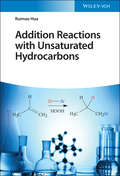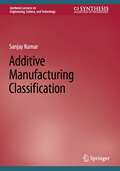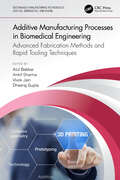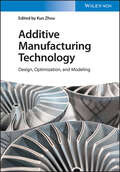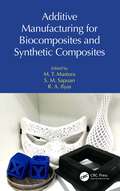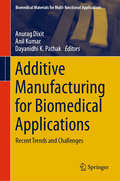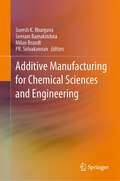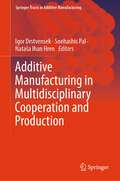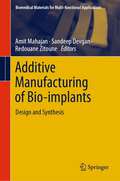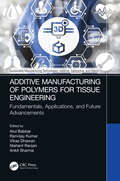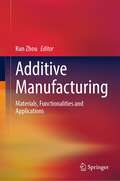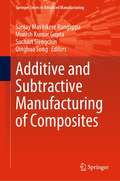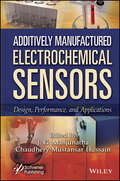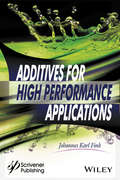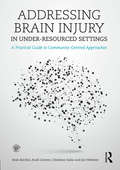- Table View
- List View
Addison-Wesley Chemistry
by Antony C. Wilbraham Dennis D. Staley Michael S. Matta Edward L. WatermanAddison-Wesley Chemistry is a comprehensive and motivating program that builds problem-solving skills and stresses the relevance and application of chemistry to the present and future life of students.
Addison-Wesley Science
by Addison-Wesley Publishing Company"This book has been made to help you learn science. It has many features to make learning science exciting. It will answer some questions you have and probably start you thinking about some new ones. Explore your book. See what features you can find. To make the most of Addison-Wesley Science, take some time to learn how it is organized. That will make science easier to understand. Find the table of contents. Notice that this book is divided into four units. Each unit focuses on a certain kind of science: life, physical, earth, or health science. Each unit consists of several chapters. Each chapter is made up of a few lessons."
Addition Reactions with Unsaturated Hydrocarbons
by Ruimao HuaAddition Reactions with Unsaturated Hydrocarbons Provides comprehensive coverage of the atom-economic approach to functionalized molecules using unsaturated hydrocarbons as starting materials Unsaturated hydrocarbons have emerged as an important class of fundamental starting materials in organic synthesis. Synthetic methodologies incorporating unsaturated hydrocarbons continue to expand due to their numerous applications in the synthesis of a vast array of chemicals. Addition Reactions with Unsaturated Hydrocarbons presents an up-to-date overview of modern methods that utilize reactions of unsaturated hydrocarbons as building blocks of organic synthesis, covering the conceptual and practical knowledge required for designing atom-efficient reactions to synthesize functionalized molecules. This authoritative volume discusses homo-dimerization and cross-dimerization of alkynes and/or alkenes, synthesis of carbonyl compounds from the hydration of alkynes, cycloadditions of alkynes and alkenes for the synthesis of carbocycles and heterocycles, double functionalization of alkynes and alkenes by addition reactions of element-element bonds, and more. Summarizes the most recent developments in the reactions of unsaturated hydrocarbons Features more than 600 schemes describing typical reactions starting from unsaturated hydrocarbons Covers topics such as alkynylated reactions, addition and cycloaddition reactions of alkynes and alkenes, and carbonylation of alkynes and alkenes with carbon monoxide Includes examples of synthesis procedures of natural products involving alkyne transformation With comprehensive coverage of important reactions of unsaturated hydrocarbons, Addition Reactions with Unsaturated Hydrocarbons is a valuable resource for organic chemists, pharmaceutical chemists, and biochemists in both academia and industry as well as an excellent reference text for graduate students in relevant areas of chemistry.
Additive Fertigung für Chemiewissenschaften und Chemieingenieurwesen
by Seeram Ramakrishna Suresh K. Bhargava Milan Brandt Pr. SelvakannanDieses Buch ist speziell für Forscher sowie Lehrende konzipiert, die einen Fortgeschrittenen-Fertigungs-Kurs in ihren Klassen unterrichten oder einführen. Es präsentiert den aktuellen Forschungsstand in diesem Forschungsbereich und die bisher identifizierten Hauptprobleme für die Integration der additiven Fertigung in chemische Prozesse. Die einzigartige Fähigkeit, Materialien mithilfe aufkommender additiver Fertigungstechnologien in funktionale Bauteile mit spezifischer Geometrie zu verwandeln, hat in Biologie, Ingenieurwissenschaften und Materialwissenschaften erhebliches Interesse geweckt, um maßgeschneiderte Designs für spezifische Anwendungen zu erstellen. Die Anwendungen dieses aufstrebenden Fertigungsverfahren im Bereich der chemischen Wissenschaften und des Ingenieurwesens sind im Anfangssdtadium. Daher liegt der Hauptfokus dieses Buches darauf, die grundlegenden Prinzipien der additiven Fertigungsverfahren sowie den Einsatz in konventionelle chemische Prozesse und verschiedeneVerfahrenstechniken einzuführen. Der potenzielle Vorteil der Anwendung dieser additiven Fertigungstechnologien besteht darin, großtechnisch chemische Prozesse herunterzuskalieren, was mehrere Vorteile bietet, darunter eine geringere Flächenbedarf, Abfallreduktion, effiziente Wärmeintegration und dezentrale chemische Fertigung. Was ist Additive Fertigung? Additive Fertigung (engl.: additive manufacturing, AM) – weitgehend auch als 3D-Druck bezeichnet – ist ein aufstrebendes und innovatives Fertigungsverfahren, das sich grundlegend von konventionellen Herstellungsprozessen unterscheidet und der Forschung und Industrie zu völlig neuen Möglichkeiten verhilft. Bauteile werden Schicht für Schicht aufgebaut und entstehen nicht wie bei herkömmlichen Verfahren durch Abtrag von Material (zum Beispiel durch fräsende Bearbeitung). Dadurch ergibt sich eine enorme Flexibilität und Designfreiheit beispielsweise bei der Herstellung von Prototypen und auch zunehmend in der Serienfertigung. Die Zukunft der additiven Fertigung Die additive Fertigung zählt zu den starken Wachstumsfeldern innerhalb der Produktion. Führende Marktberichte sagen ein durchschnittliches jährliches Wachstum von ca. 20 Prozent für die nächsten fünf Jahre voraus. Das Fraunhofer IGCV geht dabei davon aus, dass dieses Branchenwachstum der additiven Fertigung nicht nur in einem spezifischen Industriezweig zu beobachten sein wird. Vielmehr ist davon auszugehen, dass in allen Industriezweigen der Einsatz additiver Fertigungsverfahren zunehmen wird. Im Jahr 2022 wurden zur Zukunft der additiven Fertigung zwei Studien (An Additive Manufacturing Breakthrough & The Futures of Metal Additive Manufacturing 2030) veröffentlicht, bei denen das Fraunhofer IGCV Zuarbeiten geleistet hat. Die additive Fertigung zählt zu den starken Wachstumsfeldern innerhalb der Produktion. Führende Marktberichte sagen ein durchschnittliches jährliches Wachstum von ca. 20 Prozent für die nächsten fünf Jahre voraus. Das Fraunhofer IGCV geht dabei davon aus, dass dieses Branchenwachstum der additiven Fertigung nicht nur in einem spezifischen Industriezweig zu beobachten sein wird. Vielmehr ist davon auszugehen, dass in allen Industriezweigen der Einsatz additiver Fertigungsverfahren zunehmen wird. Im Jahr 2022 wurden zur Zukunft der additiven Fertigung zwei Studien (An Additive Manufacturing Breakthrough & The Futures of Metal Additive Manufacturing 2030) veröffentlicht, bei denen das Fraunhofer IGCV Zuarbeiten geleistet hat.
Additive Manufacturing Classification (Synthesis Lectures on Engineering, Science, and Technology)
by Sanjay KumarAdditive manufacturing classification is one of the biggest issues faced by AM community. The book provides a comprehensive classification of AM, which can be useful to anyone working in any area of manufacturing. As the classification depends on the interrelation of various AM processes, the book provides concise and critical information of those processes, which can be helpful to anyone looking for a concise book on AM. The book provides original information unavailable in research papers.
Additive Manufacturing Hybrid Processes for Composites Systems (Advanced Structured Materials #129)
by António Torres Marques Sílvia Esteves João P. T. Pereira Luis Miguel OliveiraThis book focuses on the emerging additive manufacturing technology and its applications beyond state-of-the-art, fibre-reinforced thermoplastics. It also discusses the development of a hybrid, integrated process that combines additive and subtractive operations in a single-step platform, allowing CAD-to-Part production with freeform shapes using long or continuous fibre-reinforced thermoplastics. The book covers the entire value chain of this next-generation technology, from part design and materials composition to transformation stages, product evaluation, and end-of-life studies. Moreover, it addresses the following engineering issues: • Design rules for hybrid additive manufacturing; • Thermoplastic compounds for high-temperature and -strength applications; • Advanced extrusion heads and process concepts; • Hybridisation strategies; • Software ecosystems for hAM design, pre-processing, process planning, emulating and multi-axis processing; • 3D path generators for hAM based on a multi-objective optimisation algorithm that matches the recent curved adaptive slicing method with a new transversal scheme; • hAM parameters, real-time monitoring and closed-loop control; • Multiparametric nondestructive testing (NDT) tools customised for FRTP AM parts; • Sustainable manufacturing processes validated by advanced LCA/LCC models.
Additive Manufacturing Processes in Biomedical Engineering: Advanced Fabrication Methods and Rapid Tooling Techniques (Sustainable Manufacturing Technologies)
by Ankit Sharma Vivek Jain Atul Babbar Dheeraj GuptaThis book covers innovative breakthroughs in additive manufacturing processes used for biomedical engineering. More and more, 3D printing is selected over traditional manufacturing processes, especially for complex designs, because of the many advantages such as fewer restrictions, better production cost savings, higher quality control, and accuracy. Current challenges and opportunities regarding material, design, cost savings, and efficiency are covered along with an outline of the most recent fabrication methods used for converting biomaterials into integrated structures that can fit best in anatomy while still obtaining the necessary architecture, mechanical reliability, biocompatibility, and anti-bacterial characteristics needed. Additional chapters will also focus on selected areas of applications such as bionics, affordable prostheses, implants, medical devices, rapid tooling, and drug delivery. Additive Manufacturing Processes in Biomedical Engineering: Advanced Fabrication Methods and Rapid Tooling Techniques acts as a first-hand reference for commercial manufacturing organizations which are mimicking tissue organs by using additive manufacturing techniques. By capturing the current trends of today’s manufacturing practices this book becomes a one-stop resource for manufacturing professionals, engineers in related disciplines, and academic researchers.
Additive Manufacturing Solutions
by Sanjay KumarThis book serves as an accelerated learning tool for students of Additive Manufacturing. The author presents key aspects of the subject in the form of questions and answers, so learners in a variety of contexts can find answers quickly to their specific question. Solutions to a variety of current, challenging problems are presented, clarified with examples, illustrations and copious references for more thorough investigation of the specific topic.Offers a unique, accelerated learning tool for students of Additive Manufacturing, presenting the subject in the form of questions and answers;Provides solutions to today’s challenging problems in additive manufacturing, using examples, illustrations and references;Includes coverage of various aspects of additive manufacturing, such as materials, design, applications, post-process and digital manufacturing.
Additive Manufacturing Technologies: Rapid Prototyping to Direct Digital Manufacturing
by David W. Rosen Ian Gibson Brent StuckerAdditive Manufacturing Technologies: Rapid Prototyping to Direct Digital Manufacturing deals with various aspects of joining materials to form parts. Additive Manufacturing (AM) is an automated technique for direct conversion of 3D CAD data into physical objects using a variety of approaches. Manufacturers have been using these technologies in order to reduce development cycle times and get their products to the market quicker, more cost effectively, and with added value due to the incorporation of customizable features. Realizing the potential of AM applications, a large number of processes have been developed allowing the use of various materials ranging from plastics to metals for product development. Authors Ian Gibson, David W. Rosen and Brent Stucker explain these issues, as well as: Providing a comprehensive overview of AM technologies plus descriptions of support technologies like software systems and post-processing approaches Discussing the wide variety of new and emerging applications like micro-scale AM, medical applications, direct write electronics and Direct Digital Manufacturing of end-use components Introducing systematic solutions for process selection and design for AM Additive Manufacturing Technologies: Rapid Prototyping to Direct Digital Manufacturing is the perfect book for researchers, students, practicing engineers, entrepreneurs, and manufacturing industry professionals interested in additive manufacturing.
Additive Manufacturing Technology: Design, Optimization, and Modeling
by Kun ZhouAdditive Manufacturing Technology Highly comprehensive resource covering all key aspects of the current developments of additive manufacturing Additive Manufacturing Technology: Design, Optimization, and Modeling provides comprehensive and in-depth knowledge of the latest advances in various additive manufacturing technologies for polymeric materials, metals, multi-materials, functionally graded materials, and cell-laden bio-inks. It also details the application of numerical modeling in facilitating the design and optimization of materials, processes, and printed parts in additive manufacturing. The topics covered in this book include: Fundamentals and applications of 4D printing, 3D bioprinting of cell-laden bio-inks, and multi-material additive manufacturing Alloy design for metal additive manufacturing, mechanisms of metallurgical defect formation, and the mechanical properties of printed alloys Modified inherent strain method for the rapid prediction of residual stress and distortion within parts fabricated by additive manufacturing Modeling of the different stages in polymer and metal additive manufacturing processes, including powder spreading, melting, and thermal stress evolution By providing extensive coverage of highly relevant concepts and important topics in the field of additive manufacturing, this book highlights its essential role in Industry 4.0 and serves as a valuable resource for scientists, engineers, and students in materials science, engineering, and biomedicine.
Additive Manufacturing for Biocomposites and Synthetic Composites
by S. M. Sapuan R. A. Ilyas M. T. MasturaAdditive Manufacturing for Biocomposites and Synthetic Composites focuses on processes, engineering, and product design applications of bio-composites and synthetic composites in additive manufacturing (AM). It discusses the preparation and material characterization and selection, as well as future opportunities and challenges. Reviews the latest research on the development of composites for AM and the preparation of composite feedstocks Offers an analytical and statistical approach for the selection of composites for AM, including characterization of material properties Emphasizes the use of environmentally friendly composites Analyzes the lifecycle including costs Considers potential new fibers, their selection, and future applications This book provides a comprehensive overview of the application of advanced composite materials in AM and is aimed at researchers, engineers, and advanced students in materials and manufacturing engineering and related disciplines.
Additive Manufacturing for Biomedical Applications: Recent Trends and Challenges (Biomedical Materials for Multi-functional Applications)
by Anil Kumar Anurag Dixit Dayanidhi K. PathakNew fabrication techniques and biomaterials have advanced significantly as attention toward healthcare innovations in recent decades has increased. This book provides a comprehensive overview of the application of additive manufacturing for biomedical devices. The book focuses on the use of biomaterial for hard and soft tissue engineering. These materials can imitate the mechanical, structural, and biological characteristics of the parent tissue, repairing or replacing its functioning. It provides details on the use of various biomaterials for different biomedical applications. It highlights the present trends and potential of various techniques and materials for various applications. The chapters in this book written by eminent experts highlight recent developments in additive manufacturing for biological mimicking and surgical planning. It discusses latest advances in various 3D printing technologies in the fabrication of biomedical devices for orthopaedic and cardiovascular applications, along with rising trends in designing and creating tissue replacement substitute simulants. This book can serve as a fundamental textbook for research in additive manufacturing, fabrication of implants or scaffolds and medical device development, biomaterials, tissue engineering, and biomedical engineering. This book can be a valuable resource for mechanical and biomedical engineers, academicians, healthcare researchers, and professionals interested in tissue engineering.
Additive Manufacturing for Biomedical Implants and Prosthetics (Advanced Materials Processing and Manufacturing)
by Pravin KumarThis book explains usage of additive manufacturing (AM) for the printing of biomedical implants and prosthetics. It elaborates on the basics of printing biomedical implants and prosthetics, including necessity, printing processes, materials, and standards followed by discussion of involved technologies, design and optimization, and post-processing. It further highlights patient response and risks of biomedical implants, including future scope. Sustainability and environmental concerns while AM of implants and process optimization are also covered.Book highlights Provides wide coverage of the contents related to additive manufacturing (AM) of bio-implants and prosthetics Details fabrication details, properties, and features of fabricated implants, their testing, and characterization Discusses environmental issues and optimization Covers economic implications of AM in biomedical industry Includes dedicated chapters on Industry 4.0 interventions and sustainability This book is aimed at graduate students and researchers in bioengineering, materials science, implant design, and fabrication.
Additive Manufacturing for Chemical Sciences and Engineering
by Seeram Ramakrishna Suresh K. Bhargava Milan Brandt Pr. SelvakannanThis book is tailored designed for both researchers as well as academics teaching or introducing Advanced Manufacturing course to their classrooms. It presents the current state of research in this field of research and major challenges identified so far, for the integration of additive manufacturing into chemical processes. Unique capability of transforming materials into functional devices with specific geometry using the emerging additive manufacturing technologies has stimulated significant interest in biology, engineering and materials science, to provide custom-made designs for tailored applications. However, the applications of this emerging technology in the field of chemical sciences and engineering have started very recently. Therefore, the major focus of this book is to introduce the basic principles of additive manufacturing practices as well as advent into conventional chemical processes and various unit operations. The potential advantage of introducing these additive manufacturing technologies has the potential to scale down large scale chemical processes into small scale, which offers several advantages including lower foot print, waste reduction and efficient heat integration as well as distributed chemical manufacturing.
Additive Manufacturing in Multidisciplinary Cooperation and Production (Springer Tracts in Additive Manufacturing)
by Igor Drstvensek Snehashis Pal Nataša Ihan HrenThis book publishes the latest findings and ideas in the field of additive manufacturing presented by authors from prominent institutions around the world at the iCAT 2023 conference. The authors address various technological and medical aspects, ranging from materials science to the specific behaviour of the technology under different working conditions. The book is divided into four sections, three of which are dedicated to the purely technological aspects of additive manufacturing, covering metal processes, polymer processes and simulation. The fourth part of the book is dedicated to the medical applications of additive manufacturing, covering areas ranging from orthopaedic surgeries to materials used in medical AM.Overall, the book provides insight into the current state of the science and applications of additive manufacturing.
Additive Manufacturing in Pharmaceuticals
by Subham BanerjeeThis book presents the different 3D/4D printing technological applications of Additive Manufacturing (AM) in Pharmaceutical Sciences. The initial chapter provides the historical perspective and current scenario of AM in pharmaceuticals. The book further discusses about different 3D printing platform technologies such as FDM, SLA, SLS, SSE, Ink-jet & binder jet principles & applications in developing advanced drug delivery systems. It also covers the methodology, materials for AM and important parameters associated with these platform technologies. The book highlights the progress and practical applications of 4D-printing technology in healthcare & pharmaceuticals fraternity as well including the essence of bioprinting in pharmaceuticals. Finally, the book reviews the regulatory guidelines, perspectives, and integration of Artificial Intelligence (AI)/Machine learning (ML) in pharmaceutical AM. This book is indeed a valuable resource for students, researchers/scholars, young start-ups/entrepreneurs, and pharmaceutical professionals by providing thorough detailing about AM in Pharmaceuticals.
Additive Manufacturing of Bio-implants: Design and Synthesis (Biomedical Materials for Multi-functional Applications)
by Redouane Zitoune Amit Mahajan Sandeep DevganThis contributed volume presents the latest research on additive manufacturing (AM) or 3D printing, one of the key techniques of novel medical devices, which can process complicated or customized structures to match the properties of human tissues. AM allows for the fabrication of devices with optimal architectures, complicated morphologies, surface integrity, and regulated porosity and chemical composition. Various AM methods can now consistently fabricate dense products for a variety of materials, comprising steels, titanium alloys, Co-Cr alloys, metal-based composites, and nanocomposites. This book elucidates the chronology of various techniques that are categorized under additive manufacturing. Moreover, the futuristic techniques or advancements in this area are also described. The available literature focuses on the microstructure and various properties of 3D-printed alloys. However, the research on the wear characteristics, corrosion resistance, and biocompatibility of 3D-printed technology for biomedical applications is limited. This book comprises the helicopter view of different surface analysis trends of additive manufactured alloys. The book can be a valuable reference for beginners, researchers, and professionals interested in bioimplant manufacturing and allied fields.
Additive Manufacturing of Polymers for Tissue Engineering: Fundamentals, Applications, and Future Advancements (Sustainable Manufacturing Technologies)
by Ankit Sharma Ranvijay Kumar Atul Babbar Vikas Dhawan Nishant RanjanApplication of additive manufacturing and tissue engineering in the fields of science and technology enables the manufacturing of biocompatible, customized, reliable, and cost-effective parts, restoring the functionality of a failed human body part. This book offers a platform for recent breakthroughs in additive manufacturing related to biomedical applications. This book highlights some of the top innovations and advances in additive manufacturing and processing technologies that are the future of the manufacturing industry while also presenting current challenges and opportunities regarding the choice of material. This book includes areas of applications such as surgical guides, tissue regeneration, artificial scaffolds, implants, and drug delivery and release. Throughout the book, an emphasis is placed on rapid tooling for engineering applications. Additive Manufacturing of Polymers for Tissue Engineering: Fundamentals, Applications, and Future Advancements acts as a first-hand source of information for academic scholars and commercial manufacturers as they make strategic manufacturing and development plans.
Additive Manufacturing: Materials, Functionalities and Applications
by Kun ZhouThis book focuses on the advances of additive manufacturing in the applications of wearable electronics, energy storage, biomedical implants and devices, drug delivery, and technologies for 4D printing, large-scale printing, and ceramics printing. It provides timely insights into the materials, functionalities, and applications of additive manufacturing.
Additive and Subtractive Manufacturing of Composites (Springer Series in Advanced Manufacturing)
by Munish Kumar Gupta Suchart Siengchin Sanjay Mavinkere Rangappa Qinghua SongThis book describes crucial aspects related to the additive and subtractive manufacturing of different composites. The first half of this book mainly deals with the various types of composite fabrication methods along with the introduction, features and mechanisms and also the processing of composite materials via additive manufacturing route. Also, the thermal, mechanical, physical and chemical properties relevant to the processing of composite materials are included in the chapters. The second half of this book primarily demonstrates an extensive section on the different types of additive manufacturing processes like selective laser sintering, selective laser melting, stereolithography, fused deposition modeling and material jetting used to fabricate the metals and polymers. Also, the chapters address the complete description of fabrication processes for metal matrix composites and polymer matrix composites. Moreover, the different methods adopted such as short peening, micro-machining, heat-treatment and solution treatment to improve the surface improvement are well discussed. This book gives many helps to researchers and students in the fields of the additive and subtractive manufacturing of different composites.
Additive, Subtractive, and Hybrid Technologies: Recent Innovations in Manufacturing (Mechanical Engineering Series)
by Seeram Ramakrishna Chander Prakash Sunpreet SinghThis book provides readers with the comprehensive insights of the recent research breakthroughs in additive, subtractive, and hybrid technologies. Further, the book examines incomparable design and manufacturing independences, as well as strategies to upgrade the product performance characteristics through collaborating additive and subtractive technologies. Indeed, the intrinsic benefits and limitations of both additive and subtractive manufacturing technologies could be merged to obtain appreciable hybridizations. The editorial team members and contributors to Additive, Subtractive, and Hybrid Technologies are highly motivated experts committed to and the advance of hybrid manufacturing technologies.
Additively Manufactured Electrochemical Sensors: Design, Performance and Applications
by Chaudhery Mustansar Hussain J. G. ManjunathaThis book is an essential guide to mastering 3D printed electrochemical sensors, offering a comprehensive roadmap from foundational principles and fabrication techniques to cutting-edge applications and real-world solutions. The rapid advancement of additive manufacturing technologies, commonly known as 3D printing, has revolutionized various fields of science and engineering. Among these, the development of electrochemical sensors has particularly benefited from additive manufacturing’s unique capabilities. This book provides an exhaustive exploration of 3D printed electrochemical sensors, from foundational principles to cutting-edge applications. By meticulously detailing design considerations, fabrication techniques, and performance evaluation metrics, it offers readers a roadmap to navigate the complexities of this interdisciplinary domain. Furthermore, with its emphasis on real-world applications and case studies, the book ensures that the knowledge imparted is not just theoretical but has practical relevance. This comprehensive guide empowers readers to harness the potential of 3D printing in the realm of electrochemical sensing, driving innovations and solutions for real-world challenges. Readers will find the book: Provides an in-depth exploration of the design principles and fabrication techniques specific to 3D printed electrochemical sensors; Features knowledge to innovate and develop customized sensors tailored to specific applications, ensuring improved sensitivity, selectivity, and longevity of the sensors; Offers insights into calibration, sensitivity assessment, durability considerations, and validation protocols, highlights challenges in performance assessment, and suggests strategies to overcome them; Explores practical applications of 3D printed electrochemical sensors across sectors like medical diagnostics, environmental monitoring, and food quality control. Audience Researchers, academics, and professionals in the fields of additive manufacturing, electrochemistry, and sensor design.
Additives for High Performance Applications: Chemistry and Applications
by Johannes Karl FinkThis book focuses on the chemistry of additives for high performance applications and a large number of chemical formulas are displayed in the text. The additives applications include: Analysis and separation techniques, such as high performance liquid chromatography, for example ionic liquids. Additives for electrical applications, such as capacitors, electrokinetic micropumps, lithium-ion batteries, and other battery types. Additives for solar cells for control of the active layer nanomorphology are documented as are additives for electrolyte membranes, fuel cells, such as membrane exchange humidifiers and coolant additives. Medical applications include high performance additives for the manufacture of scaffolds, controlled drug release, and nanofibers. Additives for lubricants including the deposit control, anti-wear additives, fluid loss control additives in drilling applications. Additives for concrete uses such as set retarders, curing accelerators, defoamers, permeability control additives, and corrosion protection additives.
Addressing Brain Injury in Under-Resourced Settings: A Practical Guide to Community-Centred Approaches
by Rudi Coetzer Ross Balchin Christian Salas Janice WebsterMany of the world’s population have no access to appropriate diagnostic, neurorehabilitative or support services following brain injury. Addressing Brain Injury in Under-Resourced Settings: A Practical Guide to Community-Centred Approaches tackles this unacceptable gap in service provision by empowering the reader to provide basic care, education and support for patients with brain injuries and their families. Written for an audience which does not necessarily have any prior knowledge of the brain, neurorehabilitation or brain injuries/pathologies, this practical guide first examines the global context of brain injury, considering the cross-cultural realities across communities worldwide. The book goes on to explore the reality of brain injury and how to work with its consequences, offering practical knowledge and advice in a user-friendly, richly illustrated format. It provides easily digestible information about the brain, including its normal functioning and the ways in which it can be damaged through injury and disease. The book also covers the basic skills needed to identify neurological difficulties and provides guidance on basic rehabilitation input and support. The final section of the book covers how to provide services, including working with organisations and communities, volunteering, initiating and developing community-based projects and programmes, and caring for patients and their families from emergency to recovery to rehabilitation. This book is an invaluable resource for community health workers, voluntary sector workers and all professional healthcare providers who work with brain-injured patients around the world. It will also be important reading for policy developers, fundraising organisations and those who work with global humanitarian initiatives.
Addressing Special Educational Needs and Disability in the Curriculum: Design And Technology (Addressing SEND in the Curriculum)
by Louise T. DaviesThe SEND Code of Practice (2015) reinforced the requirement that all teachers must meet the needs of all learners. This topical book provides practical, tried-and-tested strategies and resources that will support teachers in making design and technology lessons accessible and interesting for all pupils, including those with special educational needs. The author draws on a wealth of experience to share her understanding of special educational needs and disabilities and show how the design and technology teacher can reduce or remove any barriers to learning. Offering strategies that are specific to the context of design and technology teaching, this book will enable teachers to: better identify a student’s particular learning requirements; set inclusive design and making assignments which allow all students to participate and succeed; build students’ confidence in using a range of materials and tools; assist with design tasks where pupils take ownership of their work and learning; adapt the classroom environment to meet the needs of pupils; create a mutually supportive classroom which maximises learning opportunities. An invaluable tool for continuing professional development, this text will be essential for design and technology teachers (and their teaching assistants) seeking to include and motivate all pupils in their lessons, regardless of their individual needs. This book will also be of interest to secondary SENCOs, senior management teams and ITT providers. In addition to free online resources, a range of appendices provide design and technology teachers with a variety of pro forma and activity sheets to support effective teaching. This is an essential tool for design and technology teachers and teaching assistants, and will help to deliver successful, inclusive lessons for all pupils.


